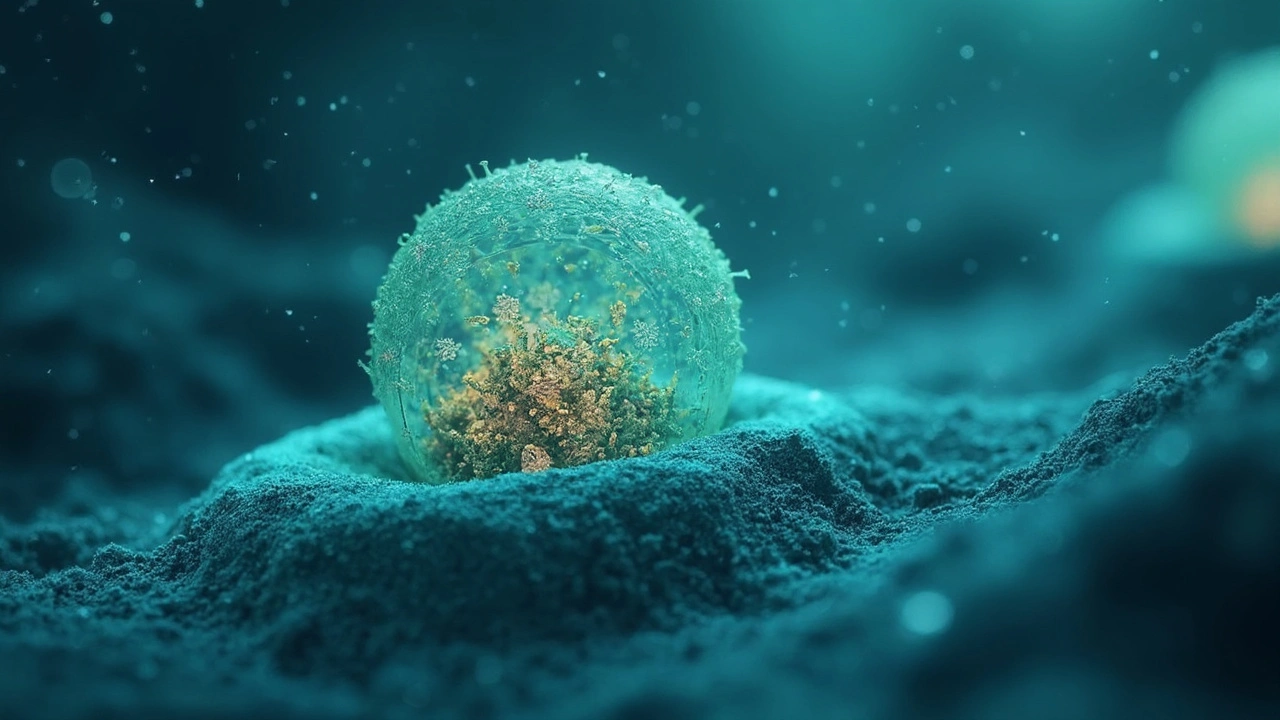Bioenergetics Explained: Unlocking the Secrets to Your Body's Energy

Ever wonder why some days you’re buzzing with energy and others you can barely get out of bed? It mostly comes down to bioenergetics, which is the study of how your body makes and uses energy to keep everything working. We’re talking about everything from blinking your eyes to running a marathon. This isn’t just about food or sleep—bioenergetics connects the tiny things happening in your cells to the way you feel every day.
When you eat, your food’s not just filling your stomach—it’s getting broken down into the fuel your cells need. This fuels your muscles, organs, and even your brain. Most people think energy starts and ends with calories, but the real action happens way deeper, inside your cells where mitochondria turn those calories into actual power. If your body’s bioenergetics isn’t working right, you can feel sluggish, have trouble focusing, or find it tough to recover after exercise.
Want more energy for your busy life? Paying attention to the basics of bioenergetics can help. Not only will you learn how energy is made, but you’ll also pick up some game-changing tips to maximize what you’ve got. Stick around to find out how to make your body’s energy engines work in your favor.
- What Is Bioenergetics?
- How Your Body Makes Energy
- Meet the Mitochondria: The Power Plants
- Why Energy Balance Matters
- Everyday Habits for Better Energy
- The Future of Bioenergetics
What Is Bioenergetics?
So, let’s break down bioenergetics in the simplest way. It’s all about how living things—yep, that includes you—use and manage energy. We’re not just talking about feeling pumped after coffee or wiped out after a run. Bioenergetics looks at the nitty-gritty: how your body changes food, oxygen, and even fat into the fuel your cells need.
At its core, bioenergetics is connected to energy metabolism. That means all the chemical reactions inside you that break down food and make energy to keep you moving, thinking, and even sleeping. This isn’t just for science majors; these chemical reactions happen non-stop, 24/7, in every cell you have.
The real MVPs here? Your mitochondria. They’re like tiny batteries in your cells, taking what you eat and breathing in, then turning it into usable energy. The end product is something called ATP (adenosine triphosphate), which is basically your body’s ‘energy currency.’ Without enough ATP, nothing in your body runs smoothly.
The basics of bioenergetics come down to three main things:
- How you get energy from food (carbs, fats, proteins)
- How your cells turn that into ATP using mitochondria
- How efficiently your body handles this entire process
When the process is on point, you feel strong, your brain works better, and you recover faster. When it’s off, you might feel tired even after a good night’s sleep. Fun fact: a healthy adult uses between 1,500 and 3,000 calories a day turning fuel into energy. Most of that is just from basic body functions, not even counting workout sessions.
| Energy Output | Approximate Daily % |
|---|---|
| Basal Metabolic Rate (basic functions) | 60-75% |
| Physical Activity | 15-30% |
| Digestion (thermic effect of food) | 10% |
Knowing the basics of bioenergetics can help you understand why you feel low on energy and what you can do to boost it. This is the science that links your fitness, your diet, and how you feel every day.
How Your Body Makes Energy
Your body has a surprisingly cool way of turning food into fuel. The magic starts when you eat—your body breaks down carbs, fats, and proteins from your food into simple molecules like glucose and fatty acids. These become the raw materials that your cells use to make energy. But the real action happens inside your cells, especially in little parts called mitochondria.
Mitochondria—sometimes called "the power plants"—take glucose and oxygen and make something called ATP. ATP, or adenosine triphosphate, is basically your body’s main energy currency. The more ATP you have, the more energy your body gets to do things, from thinking to walking to repairing muscles after a tough workout.
Here’s how the process usually goes down:
- You eat a meal and your body digests it, breaking food down into glucose and other small stuff your cells can use.
- Glucose enters your bloodstream and gets delivered to your cells.
- Your cells use mitochondria to combine glucose with oxygen (which you get from breathing) to make ATP.
- Any extra glucose? Your body can store it in your muscles or liver for later, or turn it into fat if it’s not needed soon.
So, if you ever feel your energy drop around lunchtime, it’s probably because your cells are running low on easy-access fuel and need a top-up!
Interestingly, the process can shift depending on what’s available. For example, if you’re sprinting or working out super hard, your body can turn glucose into energy quickly without as much oxygen—a process called anaerobic metabolism. But for everyday stuff, your body prefers to use oxygen because it’s way more efficient at making ATP.
Fun fact: A single human cell has around 1,000 to 2,000 mitochondria. In muscle cells, the number can go even higher because muscles need loads of energy. That’s why workouts and exercise boost your energy metabolism—they actually encourage your body to make more and healthier mitochondria, so you get better at using fuel.
Check out how it all stacks up in terms of efficiency:
| Process | ATP Produced per Glucose Molecule |
|---|---|
| Aerobic (with oxygen) | ~36 |
| Anaerobic (without oxygen) | ~2 |
That’s a huge difference—so it pays off to keep your mitochondria healthy!
Meet the Mitochondria: The Power Plants
Mitochondria are often called the "power plants" of your cells, and honestly, it’s not an exaggeration. These tiny structures work day and night to turn the food you eat into real, usable energy. This process is the heart of bioenergetics. Without healthy mitochondria, your body just can’t make enough energy to keep up with what it needs.
If you’re picturing just one or two mitochondria hanging out in a cell, think again. Most human cells have hundreds, sometimes even thousands, of these little energy makers. Muscle cells? Those are packed with them, which makes sense because muscles are always demanding power—whether you’re walking to the fridge or crushing a workout. The main job of mitochondria is to do something called cellular respiration. This means they take in glucose and oxygen, then churn out ATP, which is like the battery for your body’s activities.
Check this out: your body makes and recycles your entire body weight in ATP every single day. Basically, you’re making a new set of energy batteries once every 24 hours, all thanks to your mitochondria. Here’s a quick rundown of what mitochondria actually do for energy metabolism:
- They break down carbs, fats, and proteins from your food.
- They use oxygen to make ATP.
- They control when and how your cells use energy.
- They help handle cell repair and even signal when a cell should die if it’s too damaged.
Mitochondria even have their own DNA, which is different from the DNA in the rest of your cells. This helps them function properly, but it also means they can get damaged easier from things like toxins, too much stress, or a bad diet. When your mitochondria get sluggish, your whole body feels it—think brain fog, low stamina, and slower recovery after intense exercise.
Here’s a table showing where you find the most mitochondria in your body:
| Body Part | Mitochondria Count (per cell) | Why They Need So Many |
|---|---|---|
| Muscle cells | Up to 2,500 | High energy for movement |
| Brain cells | Thousands | Constant electrical activity |
| Liver cells | 1,000–2,000 | Heavy load managing toxins & metabolism |
| Red blood cells | 0 | They push the oxygen around but don’t use it to make energy |
If you want your cellular energy to stay strong as you age, keeping your mitochondria healthy is key. Up next, I’ll show you how you can support these power plants with simple changes you can make every day.

Why Energy Balance Matters
Finding the right balance between the energy you take in and the energy your body burns makes a massive difference in how you feel, perform, and even how you age. This idea—called energy balance—is at the heart of what keeps your metabolism working the way it should.
When your cellular energy systems are running smoothly, your body handles stress better, repairs itself faster, and holds off fatigue much longer. On the flip side, if you’re running a constant deficit—like eating less than what you’re burning—you might lose weight at first, but can soon hit a wall with things like brain fog, irritability, or getting sick more often.
Too much energy intake, especially from high-calorie junk food, gets stored as fat. This can mess with energy metabolism, making your body less efficient at using the fuel you give it. Research from 2023 out of Johns Hopkins actually showed that people who kept their energy intake just 10% above what they burned for a whole year saw a jump in body fat and a drop in their ability to manage blood sugar. That means even small, ongoing imbalances add up fast.
| Energy Intake (kcal/day) | Energy Output (kcal/day) | Energy Balance | Expected Result |
|---|---|---|---|
| 2000 | 2000 | 0 | Weight Maintained |
| 1800 | 2000 | -200 | Weight Loss |
| 2200 | 2000 | +200 | Weight Gain |
Hormones also play a big role. When energy is low for a long time, your thyroid and sex hormones can slow down. That’s one reason people on crash diets often feel tired and have trouble keeping the weight off later. The trick is to make sure your energy in and out line up with your goals, without going to extremes.
- If you’re active, you need more fuel. Don’t be afraid to eat enough—just pick foods that actually give you high quality energy, like lean proteins and whole grains.
- If you feel drained or find it tough to focus, double check that you’re eating often enough to support your mitochondria—yep, they need consistent fuel.
- Track your sleep, movement, and what you eat for just one week. Usually, small changes (like moving a bit more or making breakfast count) can rebalance your energy levels within days.
Keeping your energy balance in the sweet spot means you recover faster, have sharper thinking, and just plain feel better day to day.
Everyday Habits for Better Energy
If you want to upgrade your daily energy, it’s about more than just downing another coffee. Your body’s bioenergetics depends on how you treat it day in and day out. Most people don’t realize that small habits add up to a big difference in how much energy they have to work with.
First, let’s talk about sleep. It sounds obvious, but poor sleep throws your whole energy metabolism off. When adults don’t get the recommended 7-9 hours, studies show the mitochondria—the power plants of your cells—slow down. People running on less sleep aren’t just tired: their bodies struggle to make and use energy efficiently.
What you eat matters too. Skipping meals or loading up on ultra-processed foods can put stress on your cellular energy systems. You want a steady stream of nutrients, not the sugar roller coaster. Try eating high-fiber carbs like oats or sweet potatoes, healthy fats like olive oil, and lean proteins. Foods packed with B-vitamins (whole grains, eggs, leafy greens) help mitochondria work better.
Moving your body also makes a surprising difference. Even a brisk 20-minute walk wakes up your mitochondria and improves energy production. A 2023 review found that people who moved every day had stronger mitochondria and better energy levels—no need for a fancy gym plan.
- Stay hydrated: Even mild dehydration drops energy by making it harder for the body to carry out key cell functions. Aim for at least 8 glasses of water a day.
- Manage stress: Chronic stress builds up hormones like cortisol, which mess with both bioenergetics and sleep. Try simple things: deep breathing, a walk outside, calling a friend.
- Get sunlight: A few minutes of direct sun boosts Vitamin D and sets your internal clock to help energy metabolism.
Surprisingly, people who sit less have far better energy, even if they’re not exercising. A quick stand-up or stretch every 30-60 minutes keeps energy from tanking. Here’s a quick look at how some daily habits affect your energy:
| Habit | Impact on Cellular Energy |
|---|---|
| 7-9 hours sleep | Keeps mitochondria strong, smooth energy |
| Staying hydrated | Helps cell reactions run efficiently |
| Daily movement | Boosts energy production, reduces fatigue |
| Balanced meals | Steady fuel for mitochondria |
| Stress management | Lowers damage to energy systems |
None of this is rocket science, but it works. Start stacking up these small habits and your body’s bioenergetics system will thank you with better days—and a lot more get-up-and-go.
The Future of Bioenergetics
Bioenergetics has come a long way, but some of the most exciting changes are happening right now. With modern tech and science pushing forward, we’re learning more about how to tweak our bodies’ energy systems to boost health and performance. For example, researchers are studying how changing cellular energy pathways can potentially slow down aging or help with diseases like diabetes and even cancer. This isn’t science fiction—there are already small studies showing that certain ways of eating or moving can literally change how our mitochondria work.
Wearable devices are popping up everywhere, tracking things like metabolism, daily energy usage, and even sleep cycles. These tools give us more info about our own energy metabolism than ever before, turning bioenergetics into something practical that anyone can use. In the next few years, you might see personal health plans built around your unique mitochondria type or energy needs, kind of like how custom workouts are made today.
Here’s what’s coming up in bioenergetics research and health:
- Drugs and supplements aiming to supercharge mitochondria, possibly helping people with chronic fatigue or metabolic issues.
- New diets and fasting methods designed to spark better cell energy flow, like time-restricted eating or ketogenic diets.
- Personal health tracking for real-time updates on your energy use and potential risks—tailored to your own biology.
- Therapies targeting mitochondrial health for aging, muscle loss, or brain disorders.
One study in 2024 showed that people who did interval training improved their mitochondrial function by nearly 40% in just a few months. That tells us the future is not just about what we eat, but how we move and manage our energy on a daily basis.
While there’s a lot left to figure out, the main thing is we’ve barely scratched the surface. With more research, you’ll probably see affordable tests and simple hacks to check up on your cellular energy—giving regular folks the tools to take control of their energy and health without guesswork.





